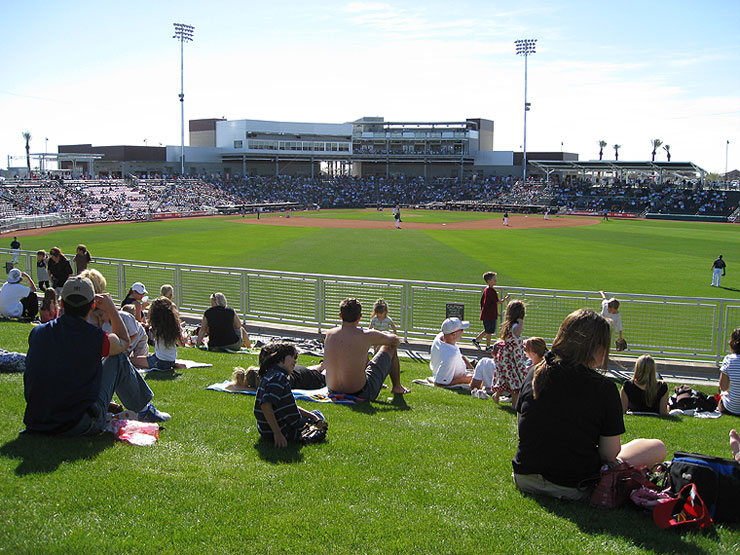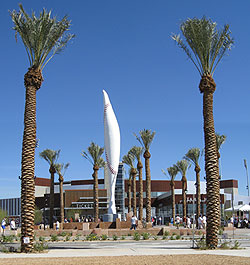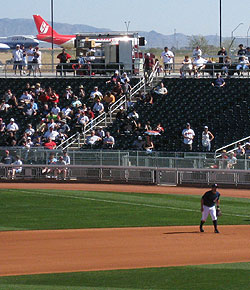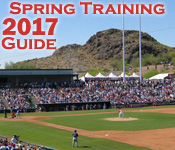
|
Thanks to the ambitious western Phoenix suburb of Goodyear, the Majors’ two Ohio-based teams decided to move their training operations to what is now the smallest city in the Cactus League.
But despite its relatively small population base (circa 60,000 in 2009), Goodyear was able to woo the Cleveland Indians and Cincinnati Reds out west by spending more money to build a spring training complex than any city or county ever had. And as a result the Cactus League will be two teams bigger by 2010, when the Reds join the Indians at the $108 million Goodyear Ballpark and Recreational Complex, which hosted its first game on February 25, 2009.
So what did the teams and city get for all that money spent?
For starters, 100-acres of practice fields that makes up the Recreational Complex portion. That translates into a dozen ball fields, six each for the Indians and Reds. The teams are allowed two practice fields for year-round use, but outside of spring training the other eight practice fields will be controlled by the City of Goodyear, which plans to use them for recreational leagues and special events. But the bulk of the money spent was done so on the main stadium, which was designed by the ballpark-building behemoth HOK Sport. Simply called the Goodyear Ballpark, it holds 10,000 fans – 8,000 in stadium seats, 1,500 on the outfield berm, and 500 in the right field pavilion party deck. Plus there’s room for a 180 more in the six suites that adjoin the press box. The ballpark itself follows the contemporary template that HOK Sport helped pioneer, highlighted by a concourse that wraps around the playing field. As is custom, the concourse is open to the action on the field, except for where the party deck and batter’s backdrop block your view from the outfield. The most impressive aspects of the ballpark actually reside outside of it, where natural and manmade objects leave a lasting impression. Although Goodyear’s ballpark has four entrance gates, all fans should use the main one behind home plate, if for no other reason than to enjoy the scenery that exists there, where the feature presentation is a three ton piece of public art commissioned from Philadelphia-based artist Donald Lipski. His $450,000 sculpture of a white wing adorned with red baseball stitching stands 60’ 6” tall, the exact distance from the pitcher’s mound to home plate. It looks like a baseball spire and is set amidst palm trees in the middle of a natural stone fountain. The folks in Goodyear really want you to see the sculpture as the ballpark’s sole set of ticket windows reside a handful of paces from it. Fans that need to pick up or purchase tickets must wait in line in the shadows of the sculpture, which has become the de facto backdrop for fans snapping their pregame portraits.
Arizona is a state noted for its mountain ranges and Goodyear Ballpark was built within eyeshot of two, the Estrella Mountains to the southeast and White Tank Mountains to the northwest. Impressive mountain vistas can be had down both outfield lines from either the Outfield Box or Outfield Reserved sections, plus from the cheap “seats” in the lawn. With the presence of big and majestic objects looming outside the ballpark feels quaint by contrast. Partially that’s because the sunken playing field makes it appear small upon approach. Stadiums half the size are far more overpowering on the local landscape, but that wasn’t the goal in Goodyear, where creating harmony with the surrounding environment was the key. As such, Goodyear Ballpark was constructed with earth tone colors, with an emphasis on shades of brown. The main exterior prominently features dark brown paneling made of a heat-resistant wood from Spain. Fans enter the ballpark at street level and descend to their seats, which are all below the 360-degree concourse. The ballpark offers its guests a surprising amount of shade, at least for those in the grandstand’s best seats. Club seating is not on a club level, but instead mixed in with box seats and even with third base. The benefit to paying a few extra bucks to sit there is that the three sections of club seating are covered by a roof, the only one found in a typically sun-drenched ballpark. Fans sitting behind home plate (sections 110-114) don't have the benefit of a roof. Instead the press box and suites block out much of the sun and by the end of the game all seats are shaded. The concourse that encircles that ballpark is as wide as it is inviting. Filled with specialty concession carts, fans are encouraged to eat and drink while upright, as numerous metallic rails behind the last row of seats allow a resting place for food and beverage. Choices for both are plentiful throughout the ballpark, and at least a half-dozen beers are available on tap. Hot Dog Nation serves up six styles of the classic ballpark staple, including Cleveland (chipotle BBQ sauce, bacon, shredded cheese, diced onion) and Cincinnati (chili, shredded cheese, diced onion) versions. A year before the Reds begin playing their exhibitions in Goodyear, the ballpark is already decked out in Cincinnati logos atop what will be their dugout and on the scoreboard, which is erected in left-center field. The backside of the scoreboard serves as the welcome billboard to the ballpark, following the example set forth in Peoria and Surprise. A handful of picnic tables are stationed in the open grass field down the left field line, while a Kids Zone fills a similar large space on the opposite side of the ballpark. Young fans will be able to enjoy one of a handful of inflatable games, ride a slow moving locomotive, or swing at wiffle balls on a mini field. Bullpens for both teams are side by side in left field. Fans are able to stand directly behind them on the berm. Unfortunately, fans can get much closer to the relief pitchers during the game than they can get to all players before or after. That’s because players enter the field through doors in the tall right field wall, away from regular folks. Above the wall resides the right field pavilion party deck, which features complimentary food, a cash bar, and an elevated view from tables on its tiered balcony. The berm in right-center is also elevated a handful of feet higher than the berm in left field. All fans will appreciate that ushers are not restrictive when it comes to moving about the ballpark’s grandstands, which have trouble filling up unless marquee teams like the Cubs or Dodgers visit. Promotions are used for all other games to help lure fans, with discounts offered for military personal, college students, seniors and even Goodyear residents. Only time will tell if the Indians or Reds will routinely fill their new showplace in the Arizona desert. But one thing’s for sure, Goodyear Ballpark is an upgrade over the teams’ previous training grounds in Florida, which explains why two ball clubs from the Buckeye state decided to move two time zones away from those that follow them back home.
Location and ParkingGoodyear is about 20 miles southwest of Phoenix. The new ballpark is just two miles south of I-10. Estrella Parkway passes directly by it. The ballpark is across the street from a recently built neighborhood of homes. It's much bigger and more noticeable neighbor to the east is the Phoenix-Goodyear Municipal Airport, where large commercial airliners sit on airport property waiting to be fixed or eventually deposed of. Numerous jets await their fate at the maintenance facility in the shadows of the ballpark. Parking for 3,000 vehicles is available around the ballpark in both paved lots and a grass field.
Ballpark Construction and HistoryIn 2004 Goodyear come close to luring the Angels away from Tempe after voters approved the supplemental funding needed to build a spring training complex. But a last-minute $20 million "improvement plan" kept the Angels' training base at Tempe Diablo Stadium and Goodyear in the lurch. Not to be deterred, the city didn't give up and on December 21, 2006 they reached an agreement to bring the Cleveland Indians a lot further west than the Angels would've had to move. For the Indians, sixteen seasons in Florida was enough and 2009 marked their return to the league they informally founded in 1947, when Cleveland and the New York Giants became the first two teams to set up permanent spring camps in Arizona. The Indians played at Hi Corbett Field in Tucson in their inaugural Cactus League season and stayed there until they departed 45 years later. The Tribe called Winter Haven's Chain of Lakes Park home from 1993-2008.
With the Indians the first team to commit to Goodyear, their portion of the complex was finished first and they began moving in on August 11, 2008, ten days after the city notified them that their development complex and clubhouse was substantially complete and ready for occupancy. The Reds’ facilities are scheduled to be completed in November 2009. Goodyear’s vision extends far beyond baseball. Their master plan calls for a ballpark village, with the ballpark serving as the anchor for mixed-use development. “Its ground-level concourse is being planned to ensure cohesive integration with surrounding restaurants, offices and a hotel/conference center,” is how the city words it. The city also assumed responsibility for finishing infrastructure construction after the two entities it hired - Civica Development and MPK/Wood Family Enterprises – became embroiled in a legal dispute after the Wood family filed for Chapter 11 bankruptcy. The Woods farmed the land the ballpark was built on until they sold it to the city and partnered with Civica to develop the retail and office space around it. Goodyear terminated their agreement with both on August 15, 2008 in order to ensure the main stadium and offsite infrastructure would be completed on time, which it was. Just as the Reds will beginning in 2010, the Indians pay $100,000 per year in rent, with upward adjustments to cover inflation. Each team signed a 20-year lease with two five-year renewal options. Cincinnati’s lease was approved unanimously by the Goodyear city council on July 14, 2008 after the city found a way to fund the additional $32 million needed to convert the complex into a two-team facility. That financing will come largely from public improvement corporation bonds, which will cost the city about $1.5 million in payments each year. The debt service will be paid primarily from Goodyear’s revolving fund budget, and could be supplemented with a proposed 1 percent increase to the hotel bed tax. More aid will eventually come from the Arizona Sports and Tourism Authority (AZSTA), the state run agency that was created to fund construction and renovations of Cactus League ballparks in Maricopa County, which Goodyear resides in. As per their policy, the AZSTA covered half the cost of the Indians' facilities. That amounted to $38 million of the $76 million price tag. For new ballparks, the AZSTA funds half the cost of one-team facilities and two-thirds for two-team facilities. The Reds' decision to move to Goodyear changed the financial equation, but by then the AZSTA's budget was depleted. The city and authority eventually reached an agreement to secure future revenues to pay for two-thirds of the revised $108 million cost of the two-team complex, which includes reimbursement to cover the 16.7% gap that city is now owed on the Indians’ facilities. If nothing else, this proves how big of a business spring training has become. But the $108 million cost of the ballpark and training complex pales in comparison to the cost of making the city’s “ballpark village” a reality. Goodyear initially estimated that total to be $1 billion. In baseball parlance, that’s four long-term contracts for players of Alex Rodriguez’s caliber. And that just further underscores how big of a business baseball has become. But A-Rod will likely never set foot in Goodyear. Instead, plenty of new offices, shops, restaurants and residences will. And, of course, the two ballclubs that spurred all of the economic activity.

Goodyear Ballpark Footnotes
| |||||||||||||||||||||||||||||||||||||||||||||||||||||||||||||||||||||||||||||||||||||||||||||||||||||||||||||||||||||||||||||||||||||||||||||||||||||||||||||||||||||||||||||||||||||||||||||||||||||||||||||||||||||||||||||



 Lipski’s choice of a wing for his sculpture was no accident, as the design pays homage to the nearby Luke Air Force Base and the next door Phoenix Goodyear Airport, where numerous large jets are parked on a runway that’s in the shadows of the team’s development complexes.
Lipski’s choice of a wing for his sculpture was no accident, as the design pays homage to the nearby Luke Air Force Base and the next door Phoenix Goodyear Airport, where numerous large jets are parked on a runway that’s in the shadows of the team’s development complexes.


